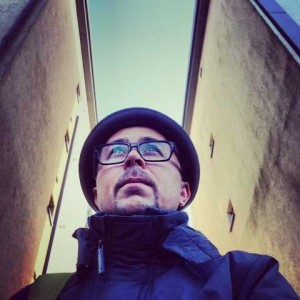
But the mini-series, which last month concluded a 10-episode second season on Starz, the premium cable service, focuses on the far less familiar young Leonardo. He is portrayed, with considerable license, as a handsome, swashbuckling, polymath genius, who gets caught up in the intrigues of the Medicis and the Pope in 15th century Florence and Rome. Series creator and main writer David Goyer, known for scripting several of the Batman movies directed by Christopher Nolan, has described the series as a “history fantasy.”
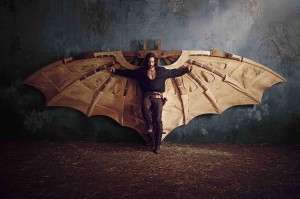
Creating such a lavish looking production was made possible through the ample application of sophisticated computer graphics to augment the production design. Tom Horton was the visual effects supervisor for the second season. Goyer said the VFX work produced “feature-level quality on a premium cable budget.”
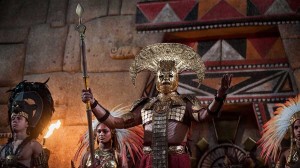 “We really punched above our weight,” observed Horton. “We went on a pretty crazy journey.” The VFX supervisor is known for his work on The King’s Speech, about England’s stuttering World War II monarch, King George VI. “There was a massive amount of CG in that film, though nobody noticed it,” he said. For Da Vinci’s Demons Horton employed both the latest in CG technology as well as more traditional effects, such as matte painting for backgrounds. The latter technique was used to create the illusion of the jungles and breathtaking valleys below Machu Picchu.
“We really punched above our weight,” observed Horton. “We went on a pretty crazy journey.” The VFX supervisor is known for his work on The King’s Speech, about England’s stuttering World War II monarch, King George VI. “There was a massive amount of CG in that film, though nobody noticed it,” he said. For Da Vinci’s Demons Horton employed both the latest in CG technology as well as more traditional effects, such as matte painting for backgrounds. The latter technique was used to create the illusion of the jungles and breathtaking valleys below Machu Picchu.
What may surprise viewers is that the visually impressive production, painted on a very broad canvas was mainly filmed in Swansea in the south of Wales at a new studio that boasts it is the largest in the world. Da Vinci’s Demons inaugurated the studio in 2012. The production was attracted to Wales not only by the facility, but also by the region’s generous tax breaks on offer. A third season will soon start shooting, again in Swansea. The show is a joint production between Starz and BBC Worldwide– owned Adjacent Productions. It is getting distributed in 120 countries.
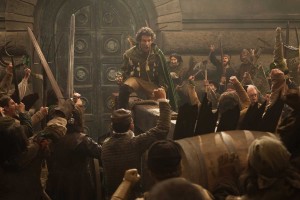 “It was amazing how many people, even professionals, thought that we actually filmed in South America,” Horton noted. “Even the show’s producers thought it wasn’t possible to do the Inca episodes without spending months on location, but I convinced them we didn’t need to go there, but could do them in Wales,” he recalled. A few members of the VFX team did travel to South America to capture photographic plates of the jungle and some beautiful scenery. These were then brought back for the matte painters to use as a precise reference.
“It was amazing how many people, even professionals, thought that we actually filmed in South America,” Horton noted. “Even the show’s producers thought it wasn’t possible to do the Inca episodes without spending months on location, but I convinced them we didn’t need to go there, but could do them in Wales,” he recalled. A few members of the VFX team did travel to South America to capture photographic plates of the jungle and some beautiful scenery. These were then brought back for the matte painters to use as a precise reference.
Other CG highpoints that Horton feels most proud of include the sequence where da Vinci and his cohorts travel in a pedal-powered submarine that dives under a slave ship before it is boarded; da Vinci also comes under attack by a 100-boat Ottoman flee, each manned by 100 rowers. In the impressive “Vault of Heaven” episode, with danger lurking in an awe-inspiring temple-like space, da Vinci faces a set of tests. In the final one he struggles but eventually manages to open a complex array of locks, leading to a chamber that appears to contain the Book of Leaves, but the vault suddenly closes.
A challenge was to create the dramatic expanse looking out from the vault. “I knew I had to get those incredible views of the valley,” he said. “So we shot 6K on a Red camera, shooting straight down into the valley. And there were 28, 4K pipes to create that massive panorama looking out of the vault of heaven.”
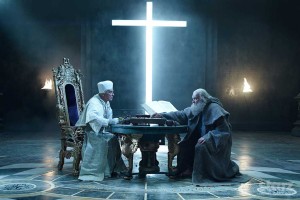 Previsualization was used sparingly. “Mostly there were storyboards available, which was great,” said the VFX supervisor. There were a few exceptions. “We had a parachute jump sequence and we completely pre-vised that.”
Previsualization was used sparingly. “Mostly there were storyboards available, which was great,” said the VFX supervisor. There were a few exceptions. “We had a parachute jump sequence and we completely pre-vised that.”
Horton employed four English firms to do the CG effects. Union VFX , based in SoHo in the heart of London, was the primary vendor. Union impressively created all of Renaissance Florence, among its many tasks. Another London VFX house, Peerless Camera, was also a key vendor. Two companies did more specialized work. One was RealFlow, whose expertise is water effects; the other was Happy Finish, a high-end special effects boutique with an expertise in lighting.
Last year, the first season of Da Vinci’s Demons won two Emmys – for original title theme music and for original title design. It was nominated for a third Emmy for outstanding visual effects in a supporting role. There is building anticipation on what will happen when the Emmy nominations will be announced for the current television season.





